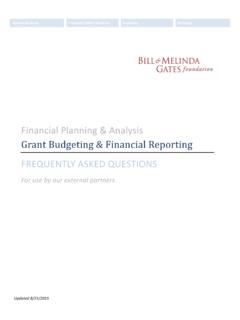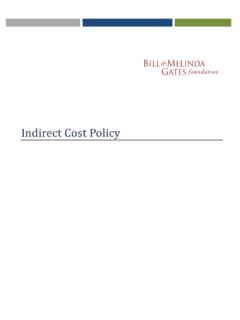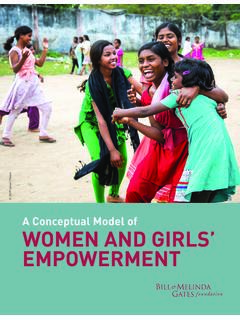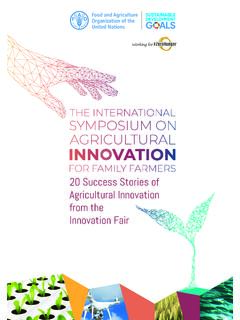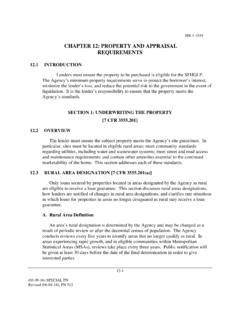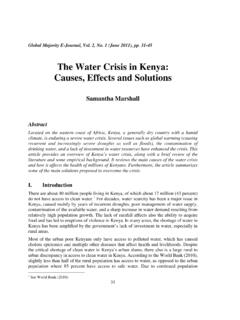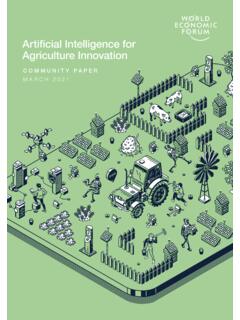Transcription of AGRICULTURAL DEVELOPMENT
1 GLOBAL DEVELOPMENT PROGRAM | AUGUST | 1 AGRICULTURAL DEVELOPMENTSTRATEGY OVERVIEWOUR MISSIONG uided by the belief that every life has equal value, the Bill & Melinda Gates Foundation works to help all people lead healthy, productive lives. In developing countries, we focus on improving people s health and giving them the chance to lift themselves out of hunger and poverty. We focus on problems that have a major impact on people, but get too little attention and funding. Our financial resources, while significant, represent a very small fraction of the overall funding needed to improve the lives of people living in extreme poverty. We therefore advocate for policies and resources to increase opportunities for people living in the developing goal of the AGRICULTURAL DEVELOPMENT initiative, the largest initiative in the foundation s Global DEVELOPMENT Program and one of the largest at the foundation, is to reduce hunger and poverty for millions of poor farm families in Sub-Saharan Africa and South Asia.
2 WHY AGRICULTURAL DEVELOPMENT ? Three-quarters of the world s poorest people get their food and income from farming small plots of land typically the size of a football field or smaller and most of them labor under difficult conditions. They grow a diversity of local crops and must deal with unique diseases, pests, and drought, as well as unproductive soil. Their livestock are Partial owners in a local farming cooperative, Francis and Juliana Mutungi, inpsect their cassava plants (Katumani, Machakos District, Kenya). Our goal: to reduce hunger and poverty for millions of poor farm families in Sub-Saharan Africa and South DEVELOPMENT PROGRAM | AUGUST | 2frequently weak or sick, resulting in reduced production of eggs and milk to eat or sell.
3 Reliable markets for their products and good information about pricing are hard to come by. Most often, government policies do not adequately serve their interests. Women are a vital part of these farms: in addition to caring for and feeding their families, they do most of the farming, but often with limited need to improve AGRICULTURAL productivity is clear: Severe hunger and poverty affects nearly 1 billion people around the world. By 2050, it s estimated that the earth s population will reach 9 billion. Global food production will need to jump by 70 percent to 100 percent to feed these people. Rising incomes, increasingly scarce resources, and a changing climate are putting additional strains on AGRICULTURAL productivity.
4 Two billion people in the developing world are malnourished. Malnutrition continues to be the world s most serious health problem and the single biggest contributor to child power of investing in agriculture is clear: AGRICULTURAL DEVELOPMENT is two to four times more effective at reducing hunger and poverty than any other sector. Helping farm families grow more is the smartest way to fight hunger and poverty. It is essential to addressing the need to feed a growing population and improving their nutrition. When farmers can grow more food and earn more income, they can achieve self-sufficiency and live better lives. Improvements in AGRICULTURAL productivity create social and economic ripple effects.
5 With increased incomes, small farmers can better feed their families, send their children to school, provide for their health, and invest in their farms. This makes their communities economically stronger and more stable. 543768210 Tons Per AcreSub-SaharanAfricaIndiaChinaUnited StatesCHART 1: AVERAGE YIELD OF CEREAL BY COUNTRYA Short History of AGRICULTURAL DevelopmentOver the past 200 years, nearly every part of the developed world has seen an AGRICULTURAL transformation. As farming improved, so did incomes, health, and recently, we ve seen amazing progress in parts of the developing world. During the Green Revolution, which took place from the 1960s to the 1980s, improvements in staple crops such as maize, wheat, and rice helped double the amount of food produced, saved hundreds of millions of lives, and drove broader DEVELOPMENT throughout much of Asia and Latin America.
6 There were also some serious unintended consequences particularly regarding the environment that left us with important lessons for today. But the efforts demonstrated that large-scale progress against hunger and poverty is possible. Following this period, there was a sense that the problem of inadequate food supply had been tackled. Governments and donors shifted their attention to other concerns. From 1980 to 2004, donor countries cut the percentage of DEVELOPMENT assistance for agriculture from more than 16 percent to less than four percent. In addition, agriculture accounted for only four percent of public spending in developing countries. The stagnation and decline in AGRICULTURAL productivity was felt most throughout much of Africa and South Asia.
7 Today, the average farmer in Sub-Saharan Africa gets just over a ton of cereal per acre, while the average Indian farmer gets about twice that, the average Chinese farmer about five times that, and the average American farmer about seven times that amount. Why is there such disparity? Farmers in other regions have tools, techniques, and resources that farmers in Africa do not. In the last several years, the global community has begun to refocus its attention on agriculture. Rising food prices and concerns about feeding a growing population are prompting more and more organizations and governments to understand the urgency of supporting AGRICULTURAL DEVELOPMENT . GLOBAL DEVELOPMENT PROGRAM | AUGUST | 3 OUR GOAL AND APPROACH Our ultimate goal is to reduce hunger and poverty for millions of poor farm families in Sub-Saharan Africa and South Asia.
8 We believe the best way to do this is by helping small farmers grow and sell more food so they can improve their nutrition, become self-sufficient, and build better succeed over the long term, we follow these key principles: We focus on small farmers. These farm families work on small plots of land, which they often rely on for their food and income. We focus on crops and livestock that are important to the rural poor in Sub-Saharan Africa and South Asia. We also concentrate on areas where most poor farmers live and where we see the greatest opportunity to help millions of people build better lives. We listen to farmers to understand the realities they face in their local areas.
9 We conduct research at the local and global levels to find out which solutions are most relevant and affordable for small farmers. We then partner with organizations that understand the local context and realities and are best suited to address these problems. We focus on helping farmers increase their productivity while preserving and enhancing the viability of soil, water, and other natural resources. We put women at the center of our work. In Sub-Saharan Africa and South Asia, women are vital participants on small farms but have limited support and little control over productive resources. We believe that AGRICULTURAL DEVELOPMENT programs must address these gender gaps and inequalities to be truly effective.
10 We realize there is no single, simple solution to tackling the challenges farm families face. That s why we take a comprehensive approach to helping farmers prosper that includes developing heartier seeds, helping them get access to new tools and farm management techniques, opening doors to markets, and supporting effective policies. We coordinate across our team to ensure we are getting the most out of our investments. For example, if we are funding the DEVELOPMENT of new seeds that withstand drought, we coordinate within our team to ensure farmers learn about the benefits of these new varieties, any special growing practices, and are comfortable adopting them. We also help connect these farmers to financing and markets.
